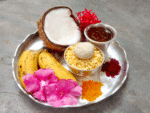What is the significance of Basant Panchami

Basant Panchami marks the onset of the spring season in India. It falls on the fifth day (Panchami) of the Hindu month of Magha(spring season) according to the Hindu calendar. As popular belief, the festival of Saraswati Puja owes its origin to the birth of Goddess Saraswati, daughter of goddess Durga. This festival is celebrated in different regions of India. In eastern parts of India, particularly in West Bengal and Bihar, it is celebrated as Saraswati Puja. Punjab celebrates it as festival of kites. People in Rajasthan wear jasmine garland to celebrate this festival. Also, according to Hindu Mythology, Lord Brahma is believed to have created the universe on this day.
History

There is an interesting history behind the reason for why we celebrate Basant Panchami. As per a popular belief, goddess Saraswati, who is said to be the deity of learning, music and art was born on this day and people worship her to achieve wisdom. Hence people are often seen celebrating Saraswati Puja on Basant Panchami.
Celebrated in educational intuitions

This festival is also celebrated in educational institutes like schools and colleges. It is said that Goddess Saraswati can bestow on her devotees lots of wisdom, learning and knowledge as the goddess is considered to be an epitome of wisdom. Students and teachers wear new clothes, offer prayers to the goddess of knowledge and various programs of song and dance are organised to please the goddess.
The significance

The significance of Basant Panchami is big in Hindu culture. The day is considered extremely auspicious to start new work, get married or perform house warming ceremony (griha pravesh).
Importance of yellow color

The colour yellow has a great significance in the celebration of Vasant Panchami as it marks the harvest time of mustard crop that has yellow blooms, which is Goddess Saraswati’s favourite colour. Yellow attire is therefore worn by the followers of Saraswati. Moreover, traditional feast is prepared for the festival wherein the dishes are usually yellow and saffron in color.
Food offered

The color of Basant is yellow which symbolizes peace, prosperity, light, energy and optimism. This is why people wear yellow clothes and make traditional delicacies in yellow hues. In Bengal and Bihar, Goddess Saraswati is offered boondi and ladoo. Sweet rice with saffron and dry fruits is made in almost every house on this occasion. Mango wood, shriphal (coconut), Ganga water, and baer are also offered, particularly by Bengalis. Traditionally, in Punjab, Maake ki Roti and Sarso Ka Saag are savoured. In Bihar, people celebrate Saraswati Puja by offering delicacies like Kheer, Malpua and Bundi to the Goddess. Like all festivals, it is marked by many traditional delicacies, like khichuri, mixed vegetables, kesar halwa, kesari bhaat, payesh, begun bhaja, sondesh and rajbhog are served as a bhog on this special day. On Murti Visthapan day, big processions are held. The idols of Maa Saraswati are immersed in the holy water of river Ganga with serenity. This the day is celebrated by savouring Dahi Chura along with gur and banana.





